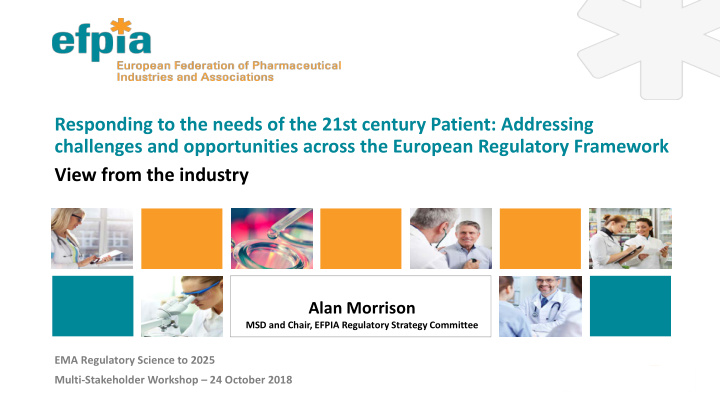



Responding to the needs of the 21st century Patient: Addressing challenges and opportunities across the European Regulatory Framework View from the industry Alan Morrison MSD and Chair, EFPIA Regulatory Strategy Committee EMA Regulatory Science to 2025 Multi-Stakeholder Workshop – 24 October 2018 1
Priorities for strengthened regulatory strategy in the EU Holding steady and slow in NAS approval times Accelerated Assessment and PRIME still exceptional routes Considering “Facilitated Regulatory Pathways” (priority, accelerated approval, conditional approval, orphan designation), EMA still offers a modest opportunity compared with other regions and countries 2 Figures from Bujar et al (2018) R&D Briefing 67: New drug approvals in six major authorities 2008-2017. Centre for Innovation in Regulatory Science. London, UK.
Regulatory Strategy Committee (RSC) – Delivering 4E for 2023 EFPIA’s 4E for 2023 Regulatory Strategy Plan, endorsed by the EFPIA Board in 2017, aims to address the challenges and opportunities faced by the EU regulatory system To drive for an agile, competitive and world-class regulatory system in The RSC Europe and beyond that embraces advances in science, technology Vision and medicines, accelerating access to innovative healthcare solutions and optimised patient outcomes. ENSURE EVOLVE ELEVATE EXPAND a competitive world-class the framework for multi-stakeholder global regulatory system innovation engagement convergence 3
Ensure a competitive, world-class regulatory system Aim for impact: Agile, competitive, world-class regulatory system that embraces advances in science technology and medicines, accelerating access to innovative healthcare solutions and optimised patient outcomes. Europe as the best place in the world to develop and license a medicines. Key metrics, EXAMPLE: Critical assessment and EFPIA position of gaps and enhancements needed in soft law and legislation in Europe, with benchmark to other regions 4
Evolve the framework for innovation Aim for impact: Regulatory system more adaptable to evolving science and technology leading to faster integration into regulatory practice. More relevant and better quality evidence that accelerates regulatory and HTA review, and supports fulsome review of value of medicines across all stakeholders, Key metrics, EXAMPLE: Demonstrating the European scientific and regulatory advice is able to qualify new sources of data and new technologies faster - joint EMA and HTA advice becomes a norm 5
Elevate multi- stakeholder involvement Aim for impact: Decisions, including on product information more adapted towards patients’ needs while ensuring the patients are appropriately engaged during the process. Broader applicability of joint advice to further streamline the new medicines development process. Study design that serves multiple stakeholders moving away from sequential data generation. Key metrics, EXAMPLE: Evidence that patient’s needs are in the center throughout the lifecycle of a medicine. Implement and optimise electronic product information (ePIL) project (infrastructure and legislative framework). 6
Expand global convergence Aim for impact: Maintaining Europe at the forefront of regulatory excellence while embracing the developments in other jurisdictions. International support for fast adaption to scientific & technological standards. Expand global convergence of regulatory standards and improve cooperation & reliance between Regulatory Authorities to shorten approval times and reduce inspection/testing. Key metrics, EXAMPLE: Agreement with EC and member states on ICH Q12 without exceptions. Reduced approval time and inspection/testing. Mutual Recognition agreements cover vaccines and waive import testing. 7
EFPIA REGULATORY STRATEGY COMMITTEE Framework to deliver the vision of 4e for 2023 To dr drive for a an n agile, c competitive ve a and w nd world-class r regulatory s system i in n Eur urope a and nd be beyond t tha hat embraces a advances i in science, technology a and medicines, accelerating a access t to i innovative healthcare solutions a and optimise sed patien ent o outcomes es. EFPIA RSC 5 year work plan developed Committed investment from industry in evidence to drive regulatory change REVEAL study on evidentiary standards and acceptance for decision-making - Prioritisation given to innovative regulatory approaches and new sources and uses of evidence to support decision making Establishing a base line and dashboard to signal the right routes for change Exploring legislative and broader mechanisms as the means for change Undertaking meaningful stakeholder engagement to engender a shared vision for regulatory innovation Returning EMA / Europe to the international regulatory science frontier 8
EMA – REGULATORY SCIENCE TO 2025 A shared agenda for excellence 4e for 2023 EMA Regulatory Science Strategy Agile, competitive, world-class regulatory systems Regulatory science as the foundation • • Ensure through analysis of gaps and Enabling and leveraging research and • • opportunities in regulatory framework innovation in regulatory science Catalysing integration of science and Embraces advances in science, technology and • • medicines technology in drug development Evolve the framework for innovation, Driving collaborative evidence generation • • addressing evidentiary sources and uses Improving the scientific quality of evaluations • To accelerate access to innovative healthcare To achieve a new and active role at the crossroads • • between science and healthcare solutions and optimized patient outcomes Elevate multi-stakeholder involvement to Advancing patient-centred access to • • focus decisions, support on patients’ needs medicines in partnership with healthcare and preferences systems Expand global convergence to deliver Addressing emerging health threats and • • availability/therapeutic challenges European leadership on regulatory standards and practices for the benefit of all 9
Recommend
More recommend